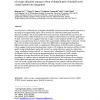67 search results - page 9 / 14 » Detecting identifiable areas in mobile environments |
AROBOTS
2010
13 years 7 months ago
2010
Locusts possess a bilateral pair of uniquely identifiable visual neurons that respond vigorously to the image of an approaching object. These neurons are called the lobula giant m...
WALCOM
2007
IEEE
13 years 9 months ago
2007
IEEE
Due to the recent growth in the demand of mobile communication services in several typical environments, the development of efficient systems for providing specialized services ha...
RSS
2007
13 years 9 months ago
2007
— Multi-robot systems require efficient and accurate planning in order to perform mission-critical tasks. However, algorithms that find the optimal solution are usually computa...
SAINT
2008
IEEE
14 years 2 months ago
2008
IEEE
In this paper we present an online algorithm that attacks the problem of placing relay nodes in regions where high localized congestion is detected. Congestion refers to the netwo...
IDA
2011
Springer
13 years 2 months ago
2011
Springer
Ubiquitous Knowledge Discovery is a new research area at the intersection of machine learning and data mining with mobile and distributed systems. In this paper the main character...

